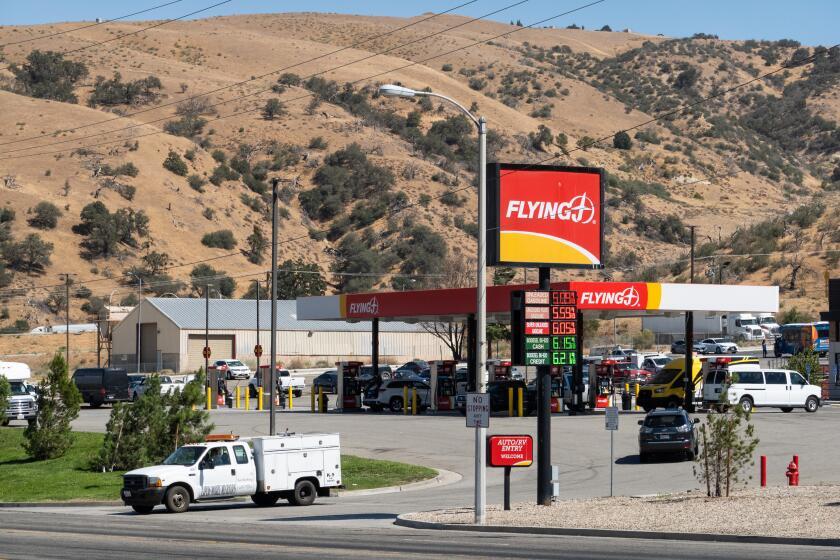5 Brush Fires Ignite Fears of a Bigger One to Come : Safety: Weather conditions helped control weekend blazes. But an abundance of dry brush has officials worried about a potential disaster when Santa Ana winds rise.
- Share via
The five brush fires that blackened hillsides and fields around Los Angeles County over the weekend sent tremors through the community of fire professionals, who have been bracing themselves for their version of the Big One.
All five fires were extinguished before daybreak Monday, but had there been a little more wind or a little less humidity the flames probably would still be raging, said Tom Harbour, fire management officer for Angeles National Forest, where fires have consumed 1,600 acres this year.
“The fire behavior we’ve seen over the weekend is substantiating the belief we had earlier in the year,” Harbour said. “All the factors . . . that could cause a disaster are in place.”
Harbour and his colleagues, whose job is to prevent fires in a region predisposed to burn, do not need psychics or seismologists to tell them that disaster could strike the minute the Santa Ana winds start blowing their hot, dry breath from the desert to the sea.
What the weekend’s fires proved to them is that the scene is set for Santa Ana season, which officially opens in two weeks. A ready wick is provided by the “fine fuels”--the now-dry grasses and weeds grew to heights of up to eight feet with the winter downpours. Waiting to pick up and carry the flames are layers of dry, oily brush left behind by the years of drought and the December, 1990, freeze.
Signs that this fall could be one of the worst fire seasons in recent history began appearing last March in vegetation samples collected twice monthly by county foresters. By weighing certain species of plants, drying them and weighing them again, the foresters determined that plants had begun hitting their peak moisture content in late March, two weeks earlier than usual, said Herb Spitzer, assistant county fire chief.
That early peak meant that the plants, far more abundant than usual because of the rains, also began drying out sooner. A temporary reprieve came with the spurts of rain earlier in the summer and the recent humidity, Spitzer said. But the current heat wave has cut that reprieve short.
“We’ll see what happens when we go out again in another week,” he said. But, he said, even a casual observer can see the hills are “getting grayish and about as dry as they’re going to get.”
At least four of the weekend fires threatened residential areas. One on Sunday afternoon in Baldwin Hills set a roof ablaze. Three other fires--one Saturday near a Chatsworth park and two Sunday evening, above Altadena and in the Antelope Valley near Lake Elizabeth--caused no damage to houses.
Another fire burned Sunday morning in the hills above the San Fernando Valley, causing Los Angeles County firefighters some concern because it skirted the Sunshine Canyon landfill, a private garbage dump.
But of the five, the Lake Elizabeth fire was the only one that was fanned by significant winds--15 m.p.h.--causing it to consume 100 acres in just three hours.
Dropping water from helicopters was credited with halting the march of some of the weekend fires. In Altadena Sunday night, water doused 80-foot walls of flame, bringing loud cheers from residents.
But under windy conditions, the effectiveness of water drops declines significantly, because “the water disperses faster than it can hit the ground,” said county Fire Inspector Devin Trone.
Fire officials said the other factor that prevented the weekend fires from spreading into residential areas was homeowners’ feverish brush clearing after the 1991 Oakland fires. Some held out hope that such clearing would continue through the fall. The California Department of Forestry has distributed a free video on fire prevention techniques, including clearing, to video rental stores around the Los Angeles area.
“From reporting fires right on down, there just seems to be more awareness this year,” said Keith Metcalfe, deputy chief for fire prevention with the state Forestry Department.
Others were less optimistic.
“We believe that after a disaster like the Oakland fire, we have a two- or three-month period where people will listen to us,” Harbour said. “People become callous about the situation after that.”
Yet fire officials added that even the strictest adherence to clearance guidelines may not be enough come the Santa Anas, when fires have historically jumped freeways and canyons.
More to Read
Sign up for Essential California
The most important California stories and recommendations in your inbox every morning.
You may occasionally receive promotional content from the Los Angeles Times.













